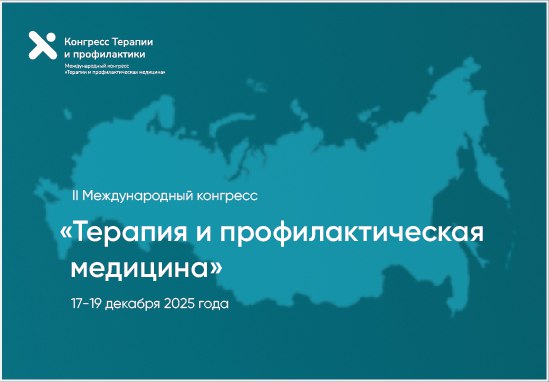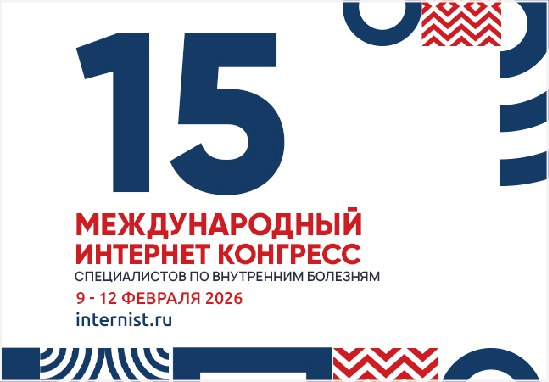Роль омега-3 полиненасыщенных жирных кислот в управлении сердечно-сосудистым риском
https://doi.org/10.15829/1728-8800-2020-2589
Аннотация
В обзоре представлена информация по современной комплексной оценке сердечно-сосудистого риска согласно Российским и европейским рекомендациям, при этом особый упор сделан на остаточный сердечно-сосудистый риск и его главный маркер — атерогенную дислипидемию. Подробно рассмотрен вклад факторов остаточного риска, в частности гипертриглицеридемии, в патогенез сердечно-сосудистых осложнений при сахарном диабете 2 типа и других комплексных метаболических заболеваниях. Приведены актуальные рекомендации по современной терапии гипертриглицеридемии. Обсуждено важное место, которое занимают препараты омега-3 полиненасыщенных жирных кислот в управлении кардиоваскулярными рисками, в контексте результатов недавно завершившихся крупных клинических исследований.
Об авторах
В. И. ПодзолковРоссия
Подзолков Валерий Иванович — доктор медицинских наук, профессор, заведующий кафедрой факультетской терапии № 2
Москва
М. В. Писарев
Россия
Писарев Михаил Владимирович — кандидат медицинских наук, доцент кафедры факультетской терапии № 2
Москва
Список литературы
1. WHO, World Health Organization. Cardiovascular diseases (CVDs), 2017, http://www.who.int/news-room/fact-sheets/detail/cardiovascular-diseases-(cvds).
2. Timmis A, Townsend N, Gale CP, et al. European Society of Cardiology: Cardiovascular Disease Statistics 2019. Eur Heart J. 2020;41(1):12-85. doi:10.1093/ehjqcco/qcz065.
3. Общая заболеваемость взрослого населения России в 2012 году. Статистические материалы. Часть IV. Москва, 2013.
4. Россия в цифрах 2019. Краткий статистический сборник. М.: Росстат. 2019.
5. Кухарчук В.В., Ежов М.В., Сергиенко И.В. и др. Диагностика и коррекция нарушений липидного обмена с целью профилактики и лечения атеросклероза. Российские рекомендации, VII пересмотр. Атеросклероз и дислипидемии. 2020;1(38):7-42. doi:10.34687/2219-8202.JAD.2020.01.0002.
6. Mach F, Baigent C, Catapano A, et al. 2019 ESC/EAS Guidelines for the management of dyslipidaemias: lipid modification to reduce cardiovascular risk. The Task Force for the management of dyslipidaemias of the European Society of Cardiology (ESC) and European Atherosclerosis Society (EAS). Eur Heart J. 2020;41(1):111-88. doi:10.1093/eurheartj/ehz455.
7. Ference BA, Ginsberg HN, Graham I, et al. Low-density lipoproteins cause atherosclerotic cardiovascular disease. Evidence from genetic, epidemiologic, and clinical studies: a consensus statement from the European Atherosclerosis Society Consensus Panel. Eur Heart J. 2017;38(32):2459-2472. doi:10.1093/eurheartj/ehx144.
8. Mihaylova B, Emberson J, Blackwell L, et al. Cholesterol Treatment Trialists. The effects of lowering LDL cholesterol with statin therapy in people at low risk of vascular disease: metaanalysis of individual data from 27 randomised trials. Lancet. 2012;380(9841):581-90. doi:10.1016/S0140-6736(12)60367-5.
9. Szummer K, Wallentin L, Lindhagen L, et al. Improved outcomes in patients with ST-elevation myocardial infarction during the last 20years are related to implementation of evidence-based treatments: experiences from the SWEDEHEART registry 1995- 2014. Eur Heart J. 2017;38(41):3056-3065. doi:10.1093/eurheartj/ehx515.
10. Bengaluru Jayanna M, Robinson JG. The extent to which statins have improved cardiovascular outcomes: Lessons from randomized trials and observational studies of “real world” practice in people with diabetes. Diabetes Obes Metab. 2019; 21 Suppl 1:17-27. doi:10.1111/dom.13701.
11. Арутюнов Г.П., Бойцов С.А., Воевода М.И. и др. Коррекция гипертриглицеридемии с целью снижения остаточного риска при заболеваниях, вызванных атеросклерозом. Заключение Совета экспертов Российского кардиологического общества, Российского научного медицинского общества терапевтов, Евразийской ассоциации терапевтов, Национального общества по изучению атеросклероза, Российской ассоциации эндокринологов и Национальной исследовательской лиги кардиологической генетики. Рациональная Фармакотерапия в Кардиологии. 2019;15(2):282-8. doi:10.20996/1819-6446-2019-15-2-282-288.
12. Fruchart JC, Sacks FM, Hermans MP, et al. The Residual Risk Reduction Initiative: a call to action to reduce residual vascular risk in dyslipidaemic patient. Diab Vasc Dis Res. 2008;5(4):319-35. doi:10.3132/dvdr.2008.046.
13. Ponte-Negretti CI, Isea-Perez JE, Lorenzatti AJ, et al. Atherogenic Dyslipidemia in Latin America: Prevalence, causes and treatment: Expert’s position paper made by The Latin American Academy for the Study of Lipids (ALALIP) Endorsed by the Inter-American Society of Cardiology (IASC), the South American Society of Cardiology (SSC), the Pan-American College of Endothelium (PACE), and the International Atherosclerosis Society (IAS). Int J Cardiol. 2017;243:516-522. doi:10.1016/j.ijcard.2017.05.059.
14. Chapman MJ, Ginsberg HN, Amarenco P, et al. Triglyceride-rich lipoproteins and high-density lipoprotein cholesterol in patients at high risk of cardiovascular disease: evidence and guidance for management. Eur Heart J. 2011;32(11):1345-61. doi:10.1093/eurheartj/ehr112.
15. Gitt AK, Drexel H, Feely J, et al. DYSIS Investigators. Persistent lipid abnormalities in statin-treated patients and predictors of LDL-cholesterol goal achievement in clinical practice in Europe and Canada. Eur J Prev Cardiol. 2012;19(2):221-30. doi:10.1177/1741826711400545.
16. Halcox JP, Banegas JR, Roy C, et al. Prevalence and treatment of atherogenic dyslipidemia in the primary prevention of cardiovascular disease in Europe: EURIKA, a cross-sectional observational study. BMC Cardiovasc Disord. 2017;17(1):160. doi:10.1186/s12872-017-0591-5.
17. Gupta M, Tummala R, Ghosh RK, et al. An update on pharmacotherapies in diabetic dyslipidemia. Prog Cardiovasc Dis. 2019;62(4):334-341. doi:10.1016/j.pcad.2019.07.006.
18. Guérin M, Le Goff W, Lassel TS, et al. Atherogenic role of elevated CE transfer from HDL to VLDL(1) and dense LDL in type 2 diabetes: impact of the degree of triglyceridemia. Arterioscler Thromb Vasc Biol. 2001;21(2):282-8. doi:10.1161/01.atv.21.2.282.
19. Mazzone T, Chait A, Plutzky J. Cardiovascular disease risk in type 2 diabetes mellitus: insights from mechanistic studies. Lancet. 2008;371(9626):1800-9. doi:10.1016/S0140-6736(08)60768-0.
20. Boekholdt SM, Arsenault BJ, Mora S, et al. Association of LDL cholesterol, non-HDL cholesterol, and apolipoprotein B levels with risk of cardiovascular events among patients treated with statins: a meta-analysis. JAMA. 2012;307(12):1302-9. doi:10.1001/jama.2012.366.
21. Sachdeva A, Cannon CP, Deedwania PC, et al. Lipid levels in patients hospitalized with coronary artery disease: an analysis of 136,905 hospitalizations in Get With The Guidelines. Am Heart J. 2009;157(1):111-117.e2. doi:10.1016/j.ahj.2008.08.010.
22. Guyton JR, Slee AE, Anderson T, et al. Relationship of lipoproteins to cardiovascular events: the AIM-HIGH Trial (Atherothrombosis Intervention in Metabolic Syndrome With Low HDL/High Triglycerides and Impact on Global Health Outcomes). J Am Coll Cardiol. 2013;62(17):1580-4. doi:10.1016/j.jacc.2013.07.023.
23. Miller M, Cannon CP, Murphy SA, et al. Impact of triglyceride levels beyond low-density lipoprotein cholesterol after acute coronary syndrome in the PROVE IT-TIMI 22 trial. J Am Coll Cardiol. 2008;51(7):724-30. doi:10.1016/j.jacc.2007.10.038.
24. Faergeman O, Holme I, Fayyad R, et al. Plasma triglycerides and cardiovascular events in the Treating to New Targets and Incremental Decrease in End-Points through Aggressive Lipid Lowering trials of statins in patients with coronary artery disease. Am J Cardiol. 2009;104(4):459-63. doi:10.1016/j.amjcard.2009.04.008.
25. Toth PP, Philip S, Hull M, Granowitz C. Association of elevated triglycerides with increased cardiovascular risk and direct costs in statin-treated patients. Mayo Clin Proc. 2019 Sep;94(9):1670- 1680. doi:10.1016/j.mayocp.2019.03.028.
26. Mason RP, Libby P, Bhatt DL. Emerging Mechanisms of Cardiovascular Protection for the Omega-3 Fatty Acid Eicosapentaenoic Acid. Arterioscler Thromb Vasc Biol. 2020;40(5):1135-1147. doi:10.1161/ATVBAHA.119.313286.
27. Mozaffarian D, Wu JH. Omega-3 fatty acids and cardiovascular disease: effects on risk factors, molecular pathways, and clinical events. J Am Coll Cardiol. 2011;58(20):2047-67. doi:10.1016/j.jacc.2011.06.063.
28. Oscarsson J, Hurt-Camejo E. Omega-3 fatty acids eicosapentaenoic acid and docosahexaenoic acid and their mechanisms of action on apolipoprotein B-containing lipoproteins in humans: a review. Lipids Health Dis. 2017;16(1):149. doi:10.1186/s12944-017-0541-3.
29. Harris WS, Ginsberg HN, Arunakul N, et al. Safety and efficacy of Omacor in severe hypertriglyceridemia. J Cardiovasc Risk. 1997;4(5-6):385-91.
30. Miller PE, Van Elswyk M, Alexander DD. Long-chain omega-3 fatty acids eicosapentaenoic acid and docosahexaenoic acid and blood pressure: a meta-analysis of randomized controlled trials. Am J Hypertens. 2014;27(7):885-96. doi:10.1093/ajh/hpu024.
31. Mozaffarian D, Geelen A, Brouwer IA, et al. Effect of fish oil on heart rate in humans: a meta-analysis of randomized controlled trials. Circulation. 2005;112(13):1945-52. doi:10.1161/CIRCULATIONAHA.105.556886.
32. O’Keefe JH, Abuissa H, Sastre A, et al. Effects of omega-3 fatty acids on resting heart rate, heart rate recovery after exercise, and heart rate variability in men with healed myocardial infarctions and depressed ejection fractions. Am J Cardiol. 2006;97(8):1127-30. doi:10.1016/j.amjcard.2005.11.025.
33. Dietary supplementation with n-3 polyunsaturated fatty acids and vitamin E after myocardial infarction: results of the GISSIPrevenzione trial. Lancet. 1999;354:447-55.
34. Weisman D, Beinart R, Erez A, et al. Effect of supplemented intake of omega-3 fatty acids on arrhythmias in patients with ICD: fish oil therapy may reduce ventricular arrhythmia. J Interv Card Electrophysiol. 2017;49(3):255-261. doi:10.1007/s10840-017-0267-1.
35. Grimsgaard S, Bønaa KH, Hansen JB, Myhre ES. Effects of highly purified eicosapentaenoic acid and docosahexaenoic acid on hemodynamics in humans. Am J Clin Nutr. 1998;68(1):52-9. doi:10.1093/ajcn/68.1.52.
36. Ghio S, Scelsi L, Latini R, et al. Effects of n-3 polyunsaturated fatty acids and of rosuvastatin on left ventricular function in chronic heart failure: a substudy of GISSI-HF trial. Eur J Heart Fail. 2010;12(12):1345-53. doi:10.1093/eurjhf/hfq172.
37. Peoples GE, Mclennan PL, Howe PR, Groeller H. Fish oil reduces heart rate and oxygen consumption during exercise. J Cardiovasc Pharmacol. 2008;52(6):540-7. doi:10.1097/FJC.0b013e3181911913.
38. Zehr KR, Walker MK. Omega-3 polyunsaturated fatty acids improve endothelial function in humans at risk for atherosclerosis: A review. Prostaglandins Other Lipid Mediat. 2018;134:131-140. doi:10.1016/j.prostaglandins.2017.07.005.
39. Wang Q, Liang X, Wang L, et al. Effect of omega-3 fatty acids supplementation on endothelial function: a meta-analysis of randomized controlled trials. Atherosclerosis. 2012;221(2):536- 43. doi:10.1016/j.atherosclerosis.2012.01.006.
40. Gao LG, Cao J, Mao QX, et al. Influence of omega-3 polyunsaturated fatty acid-supplementation on platelet aggregation in humans: a meta-analysis of randomized controlled trials. Atherosclerosis. 2013;226(2):328-34. doi:10.1016/j.atherosclerosis.2012.10.056.
41. Spite M, Serhan CN. Novel lipid mediators promote resolution of acute inflammation: impact of aspirin and statins. Circ Res. 2010;107(10):1170-84. doi:10.1161/CIRCRESAHA.110.223883.
42. O’Mahoney LL, Matu J, Price OJ, et al. Omega-3 polyunsaturated fatty acids favourably modulate cardiometabolic biomarkers in type 2 diabetes: a meta-analysis and meta-regression of randomized controlled trials. Cardiovasc Diabetol. 2018;17(1):98. doi:10.1186/s12933-018-0740-x.
43. Bersch-Ferreira ÂC, Sampaio GR, Gehringer MO, et al. Association between polyunsaturated fatty acids and inflammatory markers in patients in secondary prevention of cardiovascular disease. Nutrition. 2017;37:30-36. doi:10.1016/j.nut.2016.12.006.
44. GISSI-HF investigators. Effect of n-3 polyunsaturated acids in patients with chronic heart failure (the GISSI-HF trial): a randomized, double-blind, placebo-controlled trial. Lancet. 2008; 372(9645):1223-30. doi:10.1016/S0140-6736(08)61239-8.
45. Abdelhamid AS, Brown TJ, Brainard JS, et al. Omega-3 fatty acids for the primary and secondary prevention of cardiovascular disease. Cochrane Database Syst Rev. 2018; 7(7):CD003177. doi:10.1002/14651858.CD003177.pub3.
46. Торшин И.Ю., Громова О.А., Кобалава Ж.Д. Об ошибках метаанализов сердечно-сосудистых эффектов омега-3 ПНЖК. Часть 1. Фармакологические и клинические аспекты доказательности в эпоху постгеномных исследований, искусственного интеллекта и анализа больших данных. Эффективная фармакотерапия. 2019;15(9):26-34. doi:10.33978/2307-3586-2019-15-9-26-34.
47. Kris-Etherton PM, Richter CK, Bowen KJ, et al. Recent Clinical Trials Shed New Light on the Cardiovascular Benefits of Omega-3 Fatty Acids. Methodist DeBakey Cardiovasc J. 2019;15(3):171- 178. doi:10.14797/mdcj-15-3-171.
48. Торшин И.Ю., Громова О.А., Кобалава Ж.Д. О репрессиях ω-3 полиненасыщенных жирных кислот адептами доказательной медицины. ФАРМАКОЭКОНОМИКА. Современная фармакоэкономика и фармакоэпидемиология. 2019;12(2):91-114. doi:10.17749/2070-4909.2019.12.2.91-114.
49. Bhatt DL, Steg PG, Miller M, et al. Cardiovascular risk reduction with icosapent ethyl for hypertriglyceridemia. N Engl J Med. 2019;380(1):11-22. doi:10.1056/NEJMoa1812792.
50. Kastelein JJ, Stroes ES. FISHing for the miracle of eicosapentaenoic acid. N Engl J Med. 2019;380(1):89-90. doi: 10.1056/NEJMe1814004
Рецензия
Для цитирования:
Подзолков В.И., Писарев М.В. Роль омега-3 полиненасыщенных жирных кислот в управлении сердечно-сосудистым риском. Кардиоваскулярная терапия и профилактика. 2020;19(3):2589. https://doi.org/10.15829/1728-8800-2020-2589
For citation:
Podzolkov V.I., Pisarev M.V. Role of omega-3 polyunsaturated fatty acids in cardiovascular risk management. Cardiovascular Therapy and Prevention. 2020;19(3):2589. (In Russ.) https://doi.org/10.15829/1728-8800-2020-2589

























































